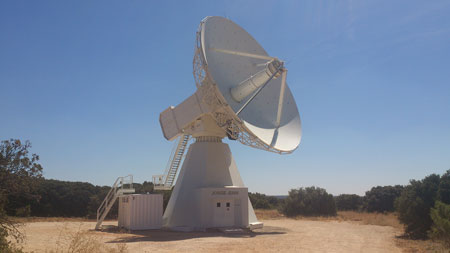| May 06, 2015 |
Improved detection of radio waves from space
|
|
(Nanowerk News) Together with their Spanish colleagues from the Instituto Geográfico Nacional and the University of Cantabria, researchers from the Fraunhofer Institute for Applied Solid State Physics IAF in Freiburg have developed a very sensitive high frequency amplifier for radio telescopes used on Earth.
|
|
The amplifier generates extremely little internal electromagnetic noise and will help measure our planet from space more precisely than ever before. The position of radio telescopes will be pinpointed with a precision to approximately one millimeter – a tenfold improvement in accuracy.
|
|
The measurement technique relies on radio telescopes picking up radio waves emitted by objects in space; the more accurately scientists can determine the positions of the radio telescopes, the more precisely they can measure various characteristics of the Earth.
|
|
“Because the radio telescopes are placed far apart at sites all round the world, they detect the radio waves at different times,” explains Dr. Mikko Kotiranta, a researcher at Fraunhofer IAF.
|
|
Determining the exact distances between telescopes becomes a matter of the accuracy with which these time lapses can be measured – a process in which every picosecond, or trillionth of a second, counts. Combining several of these measurements allows scientists to determine with the greatest accuracy variables such as the length of day and the movement of tectonic plates, poles and the Earth’s axis.
|
|
“This information is useful for a number of applications, for instance determining satellites’ orbits with greater precision,” says Kotiranta.
|
 |
| The dish of the radio telescope based in Yebes, Spain, measures more than 13 meters across. Here, the researchers will implement their high-performance radio wave reception technology for the first time.(Image: Instituto Geográfico National)
|
|
The radio waves in question come from quasars, which are supermassive black holes at the center of galaxies billions of light years away from Earth. As with any other celestial object, quasars are constantly moving through space, but they are so far away from Earth that from our perspective they appear to stand still. We also see them as a point-like objects, which makes them ideal fixed points of reference for measuring the Earth.
|
|
By the time the radio waves are picked up by the radio telescopes, however, the signal is extremely weak. This is because of the enormous distance they have had to travel through space. Another obstruction to obtaining a clear signal detection is the interfering electromagnetic noise generated by all bodies at temperatures above absolute zero – 0 Kelvin or minus 273 degrees Celsius. From an electromagnetic perspective, absolute zero would be the temperature required for total silence.
|
|
“The general rule is that the colder it is, the less noise is generated,” says Kotiranta.
|
|
A low-noise amplifier that works in the freezing cold
|
|
To address this problem, the researchers took a previous model of the amplifier and put it in an extra-cold freezer at a temperature of 22 Kelvin, or minus 251 degrees Celsius. Extreme conditions that exceed the capacities of electronic components. Or perhaps not?
|
|
To find out, the researchers at Fraunhofer IAF developed a mathematical model that describes how radio frequency circuits should be designed if they are to function at extremely low temperatures. Teaming up with their project partners, the researchersdeveloped a microwave amplifier in the cleanroom and the laboratory, which was then tested at different temperatures. They used the results to refine the model so that its forecasts corresponded more closely with the recorded data.
|
|
This updated model provided the basis for a new amplifier prototype, which the researchers continued to refine until they finally succeeded in developing a low-noise amplifier that fulfilled all the necessary requirements: an amplifier that works perfectly even at extremely low temperatures and the interfering electromagnetic noise of which was minimized.
|
|
This technology is currently in use in a newly constructed radio telescope belonging to the Instituto Geográfico National in Yebes in Spain.
|
|
“Initial trials are already being conducted,” says Kotiranta.
|
|
The project partners plan to start using the radio telescope for geodesy purposes from September onwards, for instance to measure the movement of tectonic plates. Three more large radio telescopes – each with a diameter of over 13 meters – are currently being constructed. These telescopes will be built in the Azores and the Canary Islands, and are due to enter service by the end of 2015 and 2016 respectively.
|
|
The four new telescopes will form part of the worldwide network of radio telescopes known as VGOS (Very Long Baseline Interferometry 2010 Global Observing System).
|
|
“Most telescopes date back to the 1970s and 1980s, and their technology is no longer state of the art. The new generation of telescopes will offer considerably more performance and provide us with information about our planet that is more accurate than ever before,” finishes Kotiranta.
|

